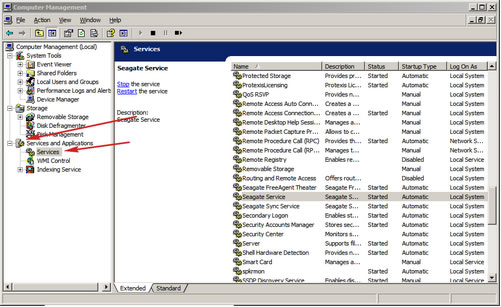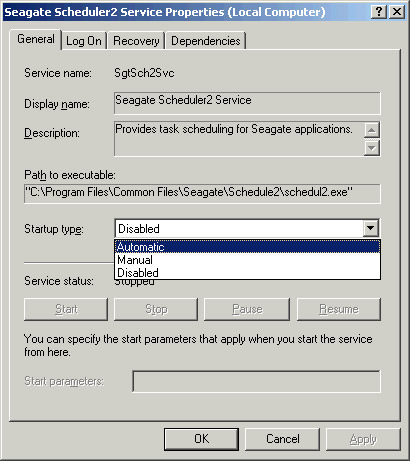Sometimes, Seagate Manager and Maxtor Manager do not see the drive.
This article focuses on drives that can be seen in Windows, but are not seen in the software.
If you are using Windows 8, please note that Seagate Manager/Maxtor Manager is not supported in Windows 8, so you will need to use a different backup solution.
First, make sure that the drive is being detected by the computer. If it is not being detected by the computer then the software will not see the drive and additional troubleshooting is needed.
After connecting the drive, please give it up to 1 minute to display in the middle of the main screen in Seagate Manager.

If the drive does not display, open My Computer (Computer for Vista) and confirm the drive is listed there. The drive should be listed as "FreeAgent Drive". If you have formatted or renamed the drive, then it will show up with the name you provided.
If the drive is detected in Windows, check if the Seagate service is running.
- Right-click on the My Computer (Computer for Vista/7) icon.
- Choose Manage.
- In the Computer Management window, click Services and Applications.
- Open the Services area.

- Scroll down the Seagate/Maxtor Service (they are listed alphabetically).
- The Seagate/Maxtor service should display Started in the Status column.
If it does not, right-click on the service and choose START. - If the service reports as Disabled, enable it to start automatically.
To do this, right-click on the service. A Status Type drop-down menu will appear. Click on the General tab. Select Automatic and click OK.

- Reboot the computer.
- If the service fails to start after you reboot with these settings, then check the logs of your Antivirus or Antispyware software to confirm they are not restricting the startup of this service, as some aggressive protection programs can prevent services from starting until you approve them. So, you may need to approve this program specifically in the Antivirus/Antispyware software. Please contact your anti-virus software support for help.
- If the service will not start or is working already, uninstall the software (for steps on uninstalling the software, see this article).
- Once the software is uninstalled, reboot the computer.
- Then reinstall the software it can be downloaded from here.
- If the drive is still not seen by the computer, connect the drive to other USB ports on the computer.
Some eSATA cards block the drive’s identity and prevent it from working. Updates have been made to Seagate Manager and to some vendors' eSATA drivers to help this issue. See our eSATA tips article for details. - If the drive still does not display after these steps, please contact Technical Support.
Check Required Windows Component Installations
1. Check to make sure you have the MSXML Parser 6.0 installed:
- Open Control Panel
- Open Add/Remove Programs / Programs & Features (Vista)
- Check box for “Show All Updates”
- Look for “MSXML Parser 6.0”
If this is not found, visit Microsoft’s website to install this component: http://www.microsoft.com/downloads/details.aspx?FamilyId=993c0bcf-3bcf-4009-be21-27e85e1857b1&displaylang=en
2. Make sure Microsoft .Net Framework 3.5 installation
- Open Control Panel
- Open Add/Remove Programs / Programs & Features (Vista)
- Check box for “Show All Updates”
- Look for “Microsoft .NET Framework 3.5”.
If this is not found, visit Microsoft’s website to install this component.
3. Try the steps listed here.
4. Remove the Seagate folder from C:\Documents and Settings\All Users\Application Data (XP) or C:\Program Data folders (Vista) and reboot.
5. Download and install the newest Windows Installer.
6. Download newest Seagate Manager from our Website and re-install a clean copy. Note: Do not do the update when the message pops up saying one is available.






